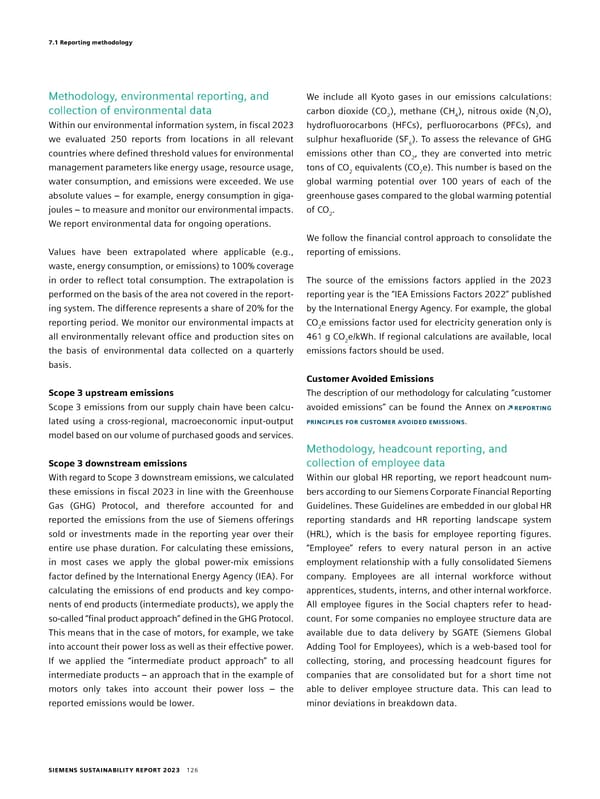7.1 Reporting methodology Methodology, environmental reporting, and We include all Kyoto gases in our emissions calculations: collection of environmental data carbon dioxide (CO ), methane (CH ), nitrous oxide (N O), 2 4 2 Within our environmental information system, in fiscal 2023 hydrofluorocarbons (HFCs), perfluorocarbons (PFCs), and we evaluated 250 reports from locations in all relevant sulphur hexafluoride (SF ). To assess the relevance of GHG 6 countries where defined threshold values for environmental emissions other than CO2, they are converted into metric management parameters like energy usage, resource usage, tons of CO equivalents (CO e). This number is based on the 2 2 water consumption, and emissions were exceeded. We use global warming potential over 100 years of each of the absolute values – for example, energy consumption in giga- greenhouse gases compared to the global warming potential joules – to measure and monitor our environmental impacts. of CO . 2 We report environmental data for ongoing operations. We follow the financial control approach to consolidate the Values have been extrapolated where applicable (e.g., reporting of emissions. waste, energy consumption, or emissions) to 100% coverage in order to reflect total consumption. The extrapolation is The source of the emissions factors applied in the 2023 performed on the basis of the area not covered in the report- reporting year is the “IEA Emissions Factors 2022” published ing system. The difference represents a share of 20% for the by the International Energy Agency. For example, the global reporting period. We monitor our environmental impacts at CO2e emissions factor used for electricity generation only is all environmentally relevant office and production sites on 461 g CO2e/kWh. If regional calculations are available, local the basis of environmental data collected on a quarterly emissions factors should be used. basis. Customer Avoided Emissions Scope 3 upstream emissions The description of our methodology for calculating “cus tomer Scope 3 emissions from our supply chain have been calcu- avoided emissions” can be found the Annex on REPORTING lated using a cross-regional, macroeconomic input-output PRINCIPLES FOR CUSTOMER AVOIDED EMISSIONS. model based on our volume of purchased goods and services. Methodology, headcount reporting, and Scope 3 downstream emissions collection of employee data With regard to Scope 3 downstream emissions, we calculated Within our global HR reporting, we report headcount num- these emissions in fiscal 2023 in line with the Greenhouse bers according to our Siemens Corporate Financial Reporting Gas (GHG) Protocol, and therefore accounted for and Guidelines. These Guidelines are embedded in our global HR reported the emissions from the use of Siemens offerings reporting standards and HR reporting landscape system sold or investments made in the reporting year over their (HRL), which is the basis for employee reporting figures. entire use phase duration. For calculating these emissions, “Employee” refers to every natural person in an active in most cases we apply the global power-mix emissions employment relationship with a fully consolidated Siemens factor defined by the International Energy Agency (IEA). For company. Employees are all internal workforce without calculating the emissions of end products and key compo- apprentices, students, interns, and other internal workforce. nents of end products (intermediate products), we apply the All employee figures in the Social chapters refer to head- so-called “final product approach” defined in the GHG Protocol. count. For some companies no employee structure data are This means that in the case of motors, for example, we take available due to data delivery by SGATE (Siemens Global into account their power loss as well as their effective power. Adding Tool for Employees), which is a web-based tool for If we applied the “intermediate product approach” to all collecting, storing, and processing headcount figures for intermediate products – an approach that in the example of companies that are consolidated but for a short time not motors only takes into account their power loss – the able to deliver employee structure data. This can lead to reported emissions would be lower. minor deviations in breakdown data. SIEMENS SUSTAINABILITY REPORT 2023 126
 Sustainability Report Page 125 Page 127
Sustainability Report Page 125 Page 127